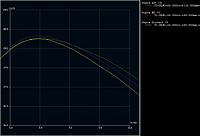The short answer is, no. A conventional tail aft airplane actually has the lowest trim drag with a small positive static margin, usually around 5 to 7% depending on the geometry, and a small down load on the tail.
http://aero.stanford.edu/Reports/MultOp/multop.html
scherrer.pagesperso-orange.fr/matthieu/aero/papers/trimdrag.PDF
Kroo, I., "Trim Drag, Tail Sizing, and Soaring Performance," Technical Soaring, Vol 8, No. 4, pp 127-137, July 1984
I ran some XFLR analysis on a Supra to see what affect the CG location has on the aerodynamic performance.
Dr. Drela plan shows the CG at 94.5mm aft of the root LE, which I calculate gives a 7% static margin. I ran the CG at 7% SM (94.5mm, stab at -2.25 degrees for trim at best L/D), 0% SM (110mm, stab at -0.75 degrees), and 12% SM (85mm, stab at -3.15 degrees).
This is 25 mm of CG location change, or about 1" requiring a change in the stab angle of about 2.4 degrees to trim at the same wing AoA, 4.75 degrees, which is the best L/D wing AoA for all three cases.
CG (mm)____SM____Stab Angle________Best L/D at 4.75degrees wing AoA
85_________12%___-3.15 degrees______28.22
94.5________7%____-2.25 degrees______28.32
110________0.5%____-0.75 degrees_____28.28
Best L/D performance comes with about 7% static margin, and the stab at -2.25 degrees, with a small down load from the stab. Exactly where Dr. Drela's plan shows it.
XFLR5 shows about a 0.3% difference in best L/D over that CG range, without accounting
...Continue Reading
 Views: 286
Views: 286  Views: 300
Views: 300 









